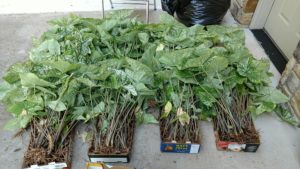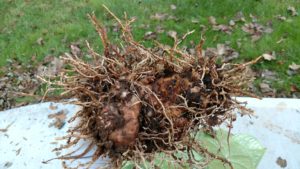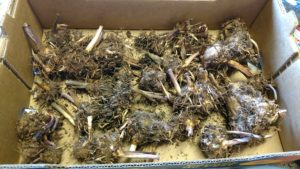Dr. Mary Lewnes Albrecht, retired dean of the Herbert College of Agriculture at the University of Tennessee, offers her recipe for overwintering caladiums. For many years Dr. Albrecht has been saving several heirloom varieties by this procedure:
#1. Plants start to go dormant in late September through October (zone 7a Tennessee) and earlier if summer weather has been dry. Signs of dormancy: foliage begins to fade, fewer new leaves emerge, and planting looks thinner. It’s time to dig.
# 2. Dig and knock as much soil off the tubers as possible. Trim the roots to about an inch in length and clip back shoots to about 3 to 4 inches in
length. Collect caladium tubers in cardboard, wooden or plastic trays. Tubers are cured when the roots and leaf bases easily come off, leaving the dormant buds behind on the tubers (usually after a week or two).
Alternative method: spread the dug tubers out on a tarp on the garage floor and let them cure.
# 3. After curing, sort tubers by size which may vary from one year to the next. Lots of consistent rainfall and hot temperatures will yield large tubers. Caladiums are tropical and thrive in summer heat and soil moisture.
# 4. Store dry tubers in open low trays. Do not stack them in deep layers. Allow good air movement around the tubers for dryness. A well-insulated garage in the 40 to 50 °F range is ideal.




 Posted in
Posted in 
